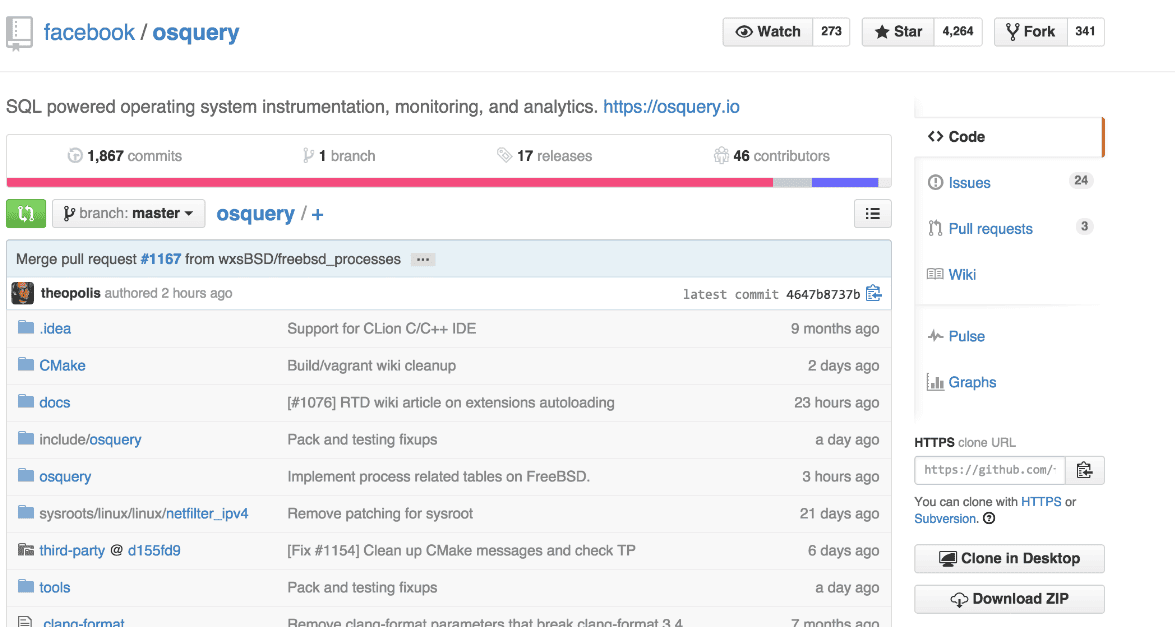
Introduction to Osquery
Have you ever wished you could question your computers directly? Osquery, an open-source tool from Facebook's security team, grants that wish!
Osquery is an open-source tool developed by Facebook's security team. It allows users to query machine states using SQL-like queries, providing detailed visibility into device states.

This makes it easier to monitor and analyze system data, such as logs, processes, and network connections, in a structured and efficient manner.
Osquery supports a wide range of platforms, including:
- Apple: Osquery supports macOS and other Apple devices.
- CentOS: Osquery supports CentOS, a popular Linux distribution.
- Ubuntu: Osquery supports Ubuntu, another popular Linux distribution.
- Windows: Osquery supports Windows operating systems.
- Since 2011, Osquery has supported almost all Linux distributions, including older ones.
Osquery's SQL-like queries allow users to easily extract specific information from the system, making it a powerful tool for security monitoring, incident response, and compliance auditing.
In the next section, you will see how Osquery works.
Get started for FREE with OpenObserve
How Osquery Works
Osquery is an open-source tool that provides detailed visibility into device states by allowing users to query machine states using SQL-like queries. It operates in two modes: osqueryi for ad-hoc queries and osqueryd for scheduling periodic background queries. Here is a detailed explanation of how Osquery works:
Basic SQL Commands
Osquery uses basic SQL commands to interact with the underlying system as a relational database. This allows users to query machine states in a structured and efficient manner. SQL commands extract specific information from the system, such as logs, processes, and network connections.
Modes of Operation
Osquery operates in two main modes:
- osqueryi: This is the interactive query console/shell. It is a standalone console that does not communicate with a daemon and does not require running as an administrator (although some tables may return fewer results when running as non-administrator). Users can prototype queries and explore the current state of their operating system using osqueryi.
- osqueryd: This is a long-lived daemon that executes repeated, periodic queries in the background. It is designed to run continuously and can be configured to execute specific queries at set intervals. osqueryd requires root or system privileges to gather detailed information.
Agent Software
Osquery employs agent software that needs root or system privileges to gather detailed information. This agent software collects data from the system and stores it in a format that can be queried using SQL commands. The agent software is designed to be lightweight and efficient, allowing it to run on a wide range of platforms without significant resource usage.
Get started for FREE with OpenObserve
Key Features
Some key features of Osquery include:
- SQL-like queries: Osquery allows users to query machine states using SQL-like commands, making extracting specific information from the system easy.
- Ad-hoc queries: osqueryi allows users to run ad-hoc queries for quick exploration and prototyping.
- Scheduled queries: osqueryd allows users to schedule periodic queries in the background, making it useful for monitoring system changes over time.
- Cross-platform support: Osquery supports a wide range of platforms, including Apple, CentOS, Ubuntu, Windows, and almost all Linux distributions since 2011.
Challenges and Solutions
While Osquery offers powerful capabilities, it also presents some challenges, such as:
- Deployment and operational complexities: Osquery requires specialized knowledge of SQL and can be difficult to deploy and manage, especially for organizations without experienced security teams.
- Data storage and management: Osquery generates large amounts of data, which must be stored and managed effectively to ensure visibility and compliance.
To address these challenges, solutions like Beyond Identity's Device360 simplify the deployment and ongoing management of Osquery, making its profound security benefits accessible to a broader range of organizations.
In the next section, you will learn about Osquery’s core applications.
Get started for FREE with OpenObserve
Core Applications of Osquery
Osquery has several core applications that make it a valuable tool for troubleshooting, security, and infrastructure management:
Troubleshooting Performance Issues
Osquery allows you to query active processes, load kernel modules, network connections, and other system information to identify and diagnose performance issues. For example, you can find the top 10 processes consuming the most memory:
sql select pid, name, uid, resident_size from processes order by resident_size desc limit 10;
Threat Detection and Incident Response
Osquery's ability to query detailed system information is invaluable for threat detection and incident response. By querying suspicious processes, network connections, file hashes, and more, you can identify unauthorized access, malware, and indicators of compromise (IOCs). This allows you to hunt for threats and quickly investigate incidents proactively.
Endpoint Security Visibility
By consolidating information from an organization's diverse array of devices and operating systems, Osquery provides IT, security, and infrastructure teams with a comprehensive view of endpoint security posture. This integrated perspective enables better decision-making and more effective management of security risks and regulatory compliance.
In summary, Osquery's core applications center around troubleshooting performance issues, enhancing threat detection and incident response and providing comprehensive endpoint security visibility. Its ability to query detailed system information using SQL makes it a powerful and flexible tool for many use cases.
In the next section, you will learn how to deploy and use Osquery.
Get started for FREE with OpenObserve
Osquery Deployment and Usage
Osquery is a powerful tool for monitoring and analyzing system data. Here are the key steps for setting up and using osquery:
Setting up Osquery
Osquery can be set up in two primary modes:
- osqueryi: This is the interactive query console/shell. It is used for immediate insights and ad-hoc queries. Users can prototype queries and explore the current state of their operating system using osqueryi.
- osqueryd: This is the long-lived daemon that executes repeated, periodic queries in the background. It is designed to run continuously and can be configured to execute specific queries at set intervals. osqueryd requires root or system privileges to gather detailed information.
Deploying Osquery
Deploying osquery across various environments requires careful consideration of necessary privileges and system compatibility. Here are some key steps:
- Install the tools: Install the osquery tools for Windows, macOS, or Linux.
- Configure and start the osqueryd service: Configure and start the osqueryd service to manage and collect query results.
- Manage and collect query results: Manage and collect query results to ensure visibility and compliance.
Formulating Queries
Formulating queries is a crucial part of using osquery effectively. Here are some examples of achieving specific information retrieval objectives:
Example 1: Identifying Running Processes
SELECT pid, name, uid, resident_size FROM processes ORDER BY resident_size DESC LIMIT 10;
Example 2: Identifying Loaded Kernel Modules
SELECT name, version, description FROM kernel_modules;
Example 3: Identifying Network Connections
SELECT local_address, remote_address, protocol FROM network_connections;
Example 4: Identifying File Hashes
SELECT path, hash FROM file_hashes;
By understanding how to set up and use osquery effectively, you can achieve specific information retrieval objectives and enhance your organization's security posture.
In the next section, you will learn about community contributions and tools you can use to understand Osquery better.
Community Contributions and Extensions
Osquery is powerful, but its true potential unfolds with the vibrant ecosystem surrounding it. Let's delve into some of the exciting resources at your disposal:
Events, Projects, and Resources
- osquery-extensions repository: This repository contains extensions for osquery, including community contributions. It includes examples of new extensions that might be contributed, such as a virtual table that actively enumerates nearby network connections.
- osquery-polylogyx extension pack: This extension pack monitors Windows socket events and includes the win_socket_events table. It requires specific versions of osquery and Windows Defender to be disabled.
Community Projects
- osquery-polylogyx extension pack: This extension pack monitors Windows socket events and includes the win_socket_events table. It requires specific versions of osquery and Windows Defender to be disabled.
- osquery-go: This is an alternative to osquery-python that allows cross-platform compilation and is more performant.
Additional Resources
- osquery documentation: The official osquery documentation provides detailed information on how to use and extend osquery, including examples of SQL queries and how to develop extensions.
- osquery community projects: The osquery community maintains a curated list of projects that help users use and extend osquery, including tools for incident detection, endpoint management, and osquery extensions.
The osquery ecosystem has community contributions and extensions that enhance its capabilities. These resources provide a wealth of information and tools for users to leverage osquery effectively in their security and IT operations.
While it has a lot of positives, you will learn about some of its limitations and challenges in the next section.
Get started for FREE with OpenObserve
Limitations and Challenges
Osquery shines as a security and monitoring tool, but like any tool, it has its limitations. Let's explore some key considerations to ensure you wield Osquery effectively:
- Real-time monitoring limitations: Osquery's primary mechanism for gathering data is through periodic polling, which can lead to delays in detecting real-time changes. This can be a limitation in scenarios where immediate detection is critical.
- Root-level access vulnerability: Osquery's reliance on root-level access to gather detailed information can make it vulnerable to tampering by users with such access. This highlights the need for robust access controls and monitoring to prevent unauthorized changes.
- Large-scale deployment considerations: In large-scale deployments, managing and collecting data from multiple osquery instances can be complex. This requires careful planning and implementation of centralized management and data collection strategies to ensure efficient and secure data processing.
Osquery is a powerful and useful tool, but it is not without its limitations and challenges. Understanding these limitations and challenges is crucial for effectively deploying and managing Osquery in various environments.
Alternatives to Osquery
Osquery stands out as a versatile tool for system monitoring and querying, but it's wise to consider how it compares to other players in the field. Let's explore some prominent alternatives:
- Auditd: Auditd is a powerful tool for monitoring system events and logs. It provides detailed information about system activities and can be used for auditing and compliance. However, it focuses more on log analysis and less on real-time monitoring and query capabilities like osquery.
- OSSEC: OSSEC is a host-based intrusion detection system with comprehensive monitoring and alerting capabilities. It is more focused on security and threat detection, whereas osquery is more focused on system monitoring and query capabilities.
- Sysdig: Sysdig is a powerful tool for system-level exploration and monitoring. It provides detailed information about system activities and can be used for troubleshooting and monitoring. However, it focuses more on system-level monitoring and less on query capabilities like osquery.
- Carbon Black: Carbon Black is a cloud-native endpoint security platform with comprehensive monitoring and threat detection capabilities. It is more focused on security and threat detection, whereas osquery is more focused on system monitoring and query capabilities.
Use Cases
- Auditd: Auditd is more suitable for auditing and compliance purposes, where detailed log analysis is required.
- OSSEC: OSSEC is more suitable for security and threat detection, where real-time monitoring and alerting are required.
- Sysdig: Sysdig is more suitable for system-level troubleshooting and monitoring where detailed system-level information is required.
- Carbon Black: Carbon Black is more suitable for comprehensive endpoint security and threat detection, where advanced threat detection and response capabilities are required.
Osquery is a powerful tool for system monitoring and query capabilities. While there are alternatives, each tool has its strengths and use cases. Understanding these differences is crucial for selecting the right tool for specific needs.
In the next section, you will learn how OpenObserve can help you with Osquery.
How can OpenObserve help?
OpenObserve can help with Osquery in several ways:
- Remote Configuration and Logging: OpenObserve can help manage Osquery's remote configuration and logging settings. It provides a simple and secure way to configure and manage Osquery instances remotely, ensuring all nodes are properly configured and reporting data correctly.
- Distributed Queries: OpenObserve supports distributed queries, allowing ad-hoc or scheduled queries to be executed across multiple Osquery instances. This enables you to collect data from multiple nodes and analyze it centrally.
- Discovery Queries: OpenObserve supports discovery queries, which allow you to control which nodes execute specific distributed queries based on system details such as operating system or architecture.
- Customizations: OpenObserve provides additional flags and options to customize Osquery's remote settings further, allowing you to tailor the tool to their specific needs and environments.
- Example Projects: OpenObserve includes projects like Doorman, which demonstrate how to implement the TLS remote settings API and use tags to generate configurations for managed nodes dynamically.
By leveraging OpenObserve, you can streamline Osquery configuration, logging, and query execution, ensuring their Osquery instances are properly managed and providing a comprehensive view of system activities.
Get started for FREE with OpenObserve
- OpenObserve Website:
- OpenObserve Article:
- OpenObserve About Us:
- OpenObserve Documentation:
- OpenObserve GitHub Repository:
Conclusion
Osquery is a powerful open-source tool that grants visibility into your devices by allowing SQL-like queries to be run against them. This enables system monitoring, analysis, and troubleshooting across various platforms. While Osquery excels in querying capabilities, it's important to consider its limitations, such as reliance on periodic polling and root-level access.
Understanding these limitations and how Osquery compares to alternatives like Auditd, OSSEC, Sysdig, and Carbon Black is crucial for selecting the right tool for your specific needs. Each tool offers unique strengths and uses cases, making a well-informed decision essential for optimizing your security and IT operations.
Resources and Bibliography
https://github.com/osquery/osquery/blob/master/docs/wiki/introduction/using-osqueryi.md
https://blog.palantir.com/osquery-across-the-enterprise-3c3c9d13ec55
https://www.beyondidentity.com/resource/osquery-transforming-endpoint-security-and-fleet-management
https://www.uptycs.com/blog/osquery-what-it-is-how-it-works-and-how-to-use-it
https://osquery.readthedocs.io/en/stable/deployment/configuration/
YouTube Reference Videos
Basics of Osquery For CyberSecurity
osquery Introduction
osquery Basics: osquery & SQL
Exploration Monitoring and Security with osquery



